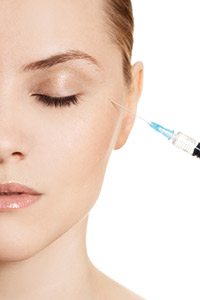
Those first few wrinkles and fine lines are starting to get to you, so you’ve decided that now’s the time to get your feet wet and try injectables for the first time. But, the sheer number of injectables available, from neurotoxins to hyaluronic acid, not to mention the number of name brands available, has your head spinning.
Don’t worry. While the variety can make choosing what’s right for you daunting, making sense of the injectable world is much easier than it seems to be. Your plastic surgeon can help you choose the type of injection, and the brand, that will give you the results you’re after.
What’s in Them
One of the first things to understand about injectables is that a lot of them contain different ingredients. Those ingredients determine what the injections will do and how long they’ll last. Botulinum toxin type A is the main ingredient in Botox and in its competitor Dysport. The main ingredient in Botox and Dysport works on the muscles, keeping them from contracting.
In contrast, injections such as Juvederm and Perlane contain hyaluronic acid, a type of sugar that plays a part in keeping skin hydrated and smooth. Unlike botulinum toxin, the human body naturally produces its own supply of hyaluronic acid. But, as you get older, that supply dwindles, making skin look less hydrated and leading to wrinkles.
Another naturally occurring substance that’s also an ingredient in injectable fillers is calcium hydroxylapatite. It’s a heavier material than hyaluronic acid and fills in lines and wrinkles in a slightly different way.
Some fillers contain a synthetic ingredient, such as poly-L-lactic acid, found in Sculptra. Calcium hydroxylapatite and poly-L-lactic acid work in somewhat similar ways, though they produce different end results. Both stimulate collagen production in the dermal layer of skin.
What They Do
Understanding ingredients is just the first step in choosing a filler. The next is to understand what those ingredients will do and whether it is what you are hoping to get from a filler. For example, Dysport and Botox are meant to be used on lines and wrinkles created by facial movements, because they act on the muscles and nerves responsible for those movements. Both are approved by the FDA for use on the frown lines, those two vertical lines that form between the eyebrows, and on the crow’s feet, the crinkly lines that develop at the corners of the eyes. When injected by a skilled and trained surgeon or injector, the botulinum toxin reduces movement in those areas, so that the skin relaxes and the wrinkle isn’t created.
Hyaluronic acid comes in variety of formulations, all of which are designed to help it fill in wrinkles or increase volume in certain areas. The thicker the hyaluronic acid filler is, the deeper it is meant to be injected. For example, Restylane and Juvederm are relatively thin forms of hyaluronic acid, while Perlane is considerably thicker and is used to treat deeper set wrinkles.
The thickest form is found in Juvederm Voluma. Voluma is actually FDA-approved to add volume to the cheek area, not for filling in wrinkles, although by volumizing the area, it will also have a smoothing effect.
Sculptra is also intended to add volume to the cheeks and facial area, but it’s main ingredient in poly-L-lactic acid, which replenishes collagen in the dermal layer. Since it works in a different way, its results also appear in a different way. While Voluma provides instant results, Sculptra needs time to work. Typically, patients receive a series of injections and the results become visible over the course of several months.
Injectables that contain calcium hydroxylapatite offer the best of both worlds. They instantly fill in lines and wrinkles. Since the calcium hydroxylapatite also stimulates the production of collagen beneath the skin, the results remain, even after the initial ingredient has worn off.
How Long they Last
Another thing to think about before your first injection is how long your results will last. Depending on the type of injection, results can last from just three months to up to two years. Botox and Dysport last the shortest amount of time, with the average results wearing off after just three or four months. Some hyaluronic acid fillers last a bit longer, anywhere from six months to year, while the results from Voluma can last for up to two years. Sculptra also lasts for up to two years, but it also needs several months to give you the results you were after.
Follow Instructions
No matter which injection you choose, it’s important that you follow any instructions given by your surgeon after the treatment. For example, your surgeon will most likely advise against rubbing the treated area or dipping your head forward for several hours after a Botox or Dysport injection. That’s because the substance can move if rubbed or if you tilt forward, leading to unpleasant side effects such as a droopy eyelid or other issues. You may also need to avoid certain pain relievers after an injection, as they can make bruising or bleeding worse.
At the Bitar Cosmetic Surgery Institute, near Washington, DC, Dr. George Bitar offers a wide range of injections. If you’re ready to give a filler or other injectable a try, call (703) 206-0506 to schedule a consultation.

George Bitar, MD, FACS is an award-winning, board-certified cosmetic and reconstructive plastic surgeon, the Founder and Medical Director of Bitar Cosmetic Surgery Institute in Virginia. He specializes in the latest surgical and minimally invasive techniques to scar management and reduction. Dr. Bitar is involved in groundbreaking research and education in plastic surgery and has authored numerous articles, abstracts, and chapters.





